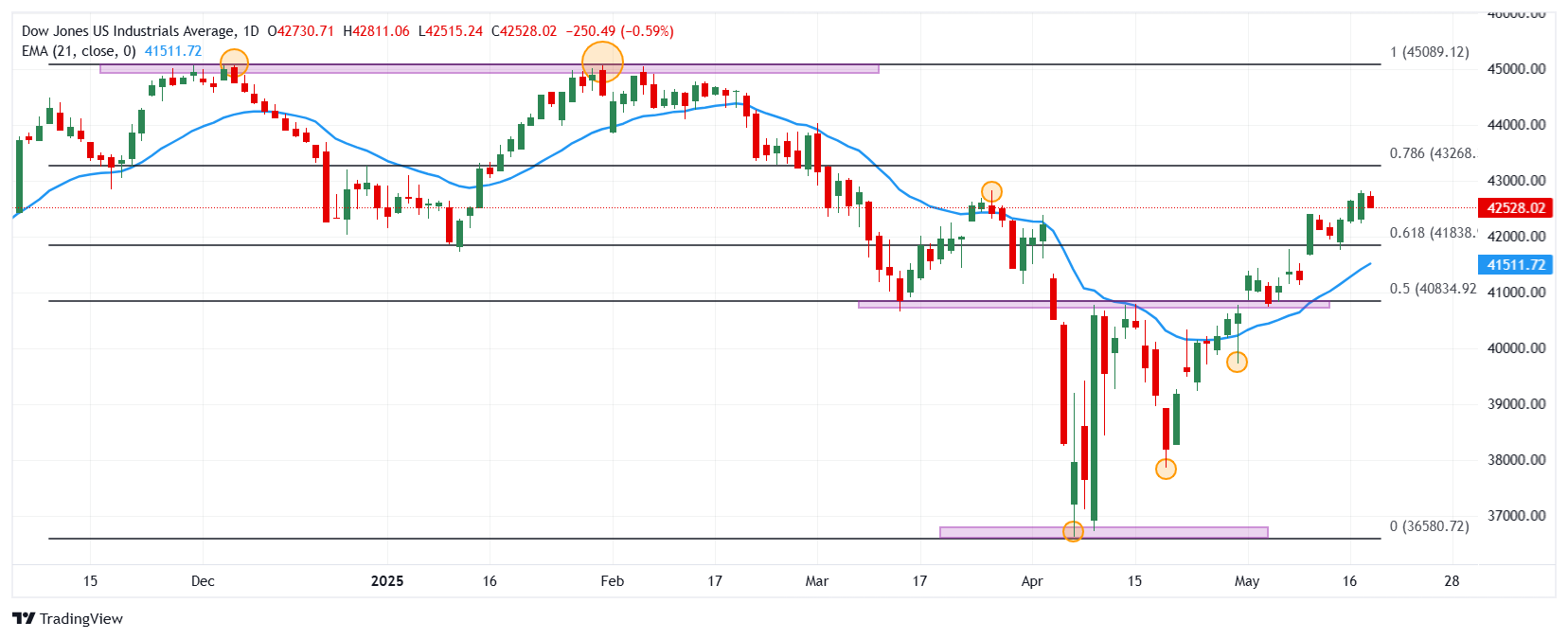- The Dow Jones decreased 0.60% on Tuesday, currently quoting at 42,520.
- The Nasdaq 100 loses 0.78% today, dragged by Airbnb Inc. (ABNB).
- The S&P 500 falls 0.71% in the day, weighed by First Isaac Corporation (FICO).
- The president of the Federal Reserve of St. Louis, Alberto Musalem, highlighted in his speech that uncertainty in economic policy is unusually high.
- Beth Hamack, president of Cleveland’s Fed, said that the White House fiscal bill complicates projections.
The Dow Jones established a maximum of the day in 42,811, where it attracted aggressive vendors that dragged the index to a minimum of the day in 42,511.
The Dow Jones industrial average began operating at 42,730, while the Nasdaq 100 technological index opened at 21,434. The S&P 500 started the day in 5,950, finishing a streak of six consecutive sessions down.
The Dow Jones quote on the negative terrain dragged by Cisco Systems and Nvidia
The Dow Jones index decoced 0.60% today, reaching a minimum of the day at 42,511.
Cisco Systems (CSCO) titles fall 1.10% in the day, reaching May 16 at $ 63.19, leading losses in Dow Jones.
Following the bassist perspective, the actions of Nvidia Corporation (NVDA), 1.07% slide on Tuesday, consolidating within the operational range of the previous session at $ 134.15.
In this sense, the Dow Jones loses 97 points, ending with a streak of 3 consecutive days upwards, operating the time of writing about 42,685.
Airbnb and Marvell Technology lead the losses in Nasdaq 100
The Nasdaq 100 technological index falls 0.78% today, marking a minimum of the day at 21,270.
Marvel Technology (MRVL) values lose 3.29% on the second day of the week, reaching May 9 at $ 159.80, spinning four consecutive sessions downward.
On the other hand, Airbnb (ABNB) shares slide 3.31% daily, visiting May 12 at $ 131.96, signing its second consecutive day with losses.
In this sense, the Nasdaq 100 goes back 163 points, remaining within the operating range of May 19 in 21,285.
The S&P 500 operates in the loss zone in the middle of the comments of the Fed members
Beth Hamack, president of the Cleveland Federal Reserve, said that government policies continue to hinder economic decision making by the Central Bank, warning a scenario of low growth with high inflation.
At the same time, the president of the Federal Reserve of St. Louis, Alberto Musalem, stressed that the uncertainty in economic policy is unusually high, warning that tariffs have a temporary effect as persistent on inflation.
The S&P 500 slides 0.71% on Tuesday, operating within the range of the previous session in 5,921, ending with a streak of six consecutive sessions. Fair Isaac Corporation Fair (FICO) shares collapse 8.02% today, reaching minimal not seen since April 25 in $ 1,900.
Technical Analysis of Dow Jones
The Dow Jones established a short -term support given by the minimum of May 6 in 40,747. The following key support is 36.614, minimum of April 7. Upwards, the important resistance is found at 45,068, a pivot point of January 31.
Dow Jones daily graphics

Dow Jones Faqs
The Dow Jones Industrial Avenge, one of the oldest stock market indexes in the world, consists of the 30 most negotiated values in the United States. The index is weighted by the price instead of capitalization. It is calculated by adding the prices of the values that compose it and dividing them by a factor, currently 0.152. The index was founded by Charles Dow, also founder of the Wall Street Journal. In recent years it has been criticized for not being sufficiently representative, since it only follows 30 companies, unlike broader rates such as S&P 500.
There are many factors that promote the Dow Jones Industrial Average (DJIA) index. The main one is the added performance of the companies that compose it, revealed in the quarterly reports of business benefits. The American and world macroeconomic data also contribute, since they influence investor confidence. The level of interest rates, set by the Federal Reserve (FED), also influences the DJia, since it affects the cost of credit, on which many companies depend largely. Therefore, inflation can be a determining factor, as well as other parameters that influence the decisions of the Federal Reserve.
Dow’s theory is a method to identify the main trend of the stock market developed by Charles Dow. A key step is to compare the direction of the Dow Jones Industrial Avenge (DJIA) and the Dow Jones Transportation Average (DJTA) and just follow the trends in which both move in the same direction. The volume is a confirmation criterion. The theory uses elements of maximum and minimum analysis. Dow’s theory raises three phases of the trend: accumulation, when intelligent money begins to buy or sell; Public participation, when the general public joins the trend; and distribution, when intelligent money abandons the trend.
There are several ways to operate with the DJ. One of them is to use ETF that allow investors to negotiate the DJ as a single value, instead of having to buy shares of the 30 companies that compose it. An outstanding example is the SPDR Dow Jones Industrial Avenge ETF (day). Future contracts on the DJ allow the specular operators about the future value of the index and the options provide the right, but not the obligation, to buy or sell the index at a predetermined price in the future. Investment funds allow investors to buy a part of a diversified portfolio of DJ values, which provides exposure to global index.
Source: Fx Street
I am Joshua Winder, a senior-level journalist and editor at World Stock Market. I specialize in covering news related to the stock market and economic trends. With more than 8 years of experience in this field, I have become an expert in financial reporting.







